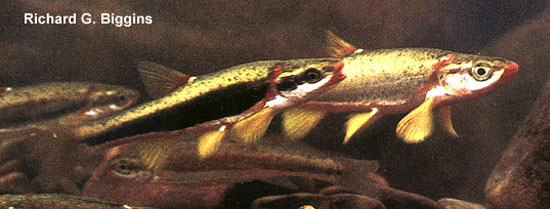| Leuciscidae (Minnows), subfamily: Laviniinae |
| 7.6 cm TL (male/unsexed); max. reported age: 4 years |
|
demersal; freshwater |
| North America: upper Cumberland River drainage (Big South Fork and above) in Kentucky and Tennessee, USA. |
|
Chrosomus cumberlandensis can be distinguished by having the following characters: two dusky stripes along side converge on caudal peduncle, coalesce into wide black stripe on large male; back and upper side with many black specks; 66-81 scales on lateral line; pharyngeal teeth 0,5-5,0; olive to green-gold above, silver white to red below; large male bright red below, behind opercle, and at base of dorsal fin; bright silver pectoral and pelvic fin bases, yellow fins; body moderately compressed; pointed snout and slightly subterminal mouth (Ref. 86798). |
| Inhabits rocky pools of headwaters and creeks. Usually found along undercut banks, near large rocks or among detritus (Ref. 86798). Feeds on attached algal growth and aquatic insect immatures (Ref. 10294). |
|
Endangered (EN); Date assessed: 03 November 2011 (B1ac(iii,iv)+2ac(iii,iv)) Ref. (130435)
|
| harmless |
Source and more info: www.fishbase.org. For personal, classroom, and other internal use only. Not for publication.

